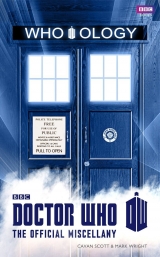
Текст книги "Doctor Who: Who-ology (Dr Who)"
Автор книги: Scott Cavan
Жанры:
Классическое фэнтези
,сообщить о нарушении
Текущая страница: 12 (всего у книги 15 страниц)




SHOCKEYE’S KITCHEN
A feast of food from around the galaxy
STARTERS
The Broth of Oblivion (The Talons of Weng-Chiang) – a warming Chinese soup, may cause drowsiness
Chimeron Jelly (Delta and the Bannermen) – cleanses the palate and makes you grow nice and strong
MAIN COURSES
Kronkburgers* (The Long Game) – on a lightly-toasted bun
Gaffabeque (Bad Wolf) – nice and hot from the planet Lucifer
Gumblejack (The Two Doctors) – cleaned, skinned and pan-fried in its own juices

Protein One (The Impossible Planet) – available with or without a dash of Protein Three
* Optional Staff of Life sauce available, made from the finest Herbabaculum vitae weed plants
All dishes come with chips cooked in Krillitane oil, the ultimate in brain food (not suitable for vegetarians)
DESSERTS
Marsh Minnows (The Trial of a Time Lord: Mindwarp) – green and slimy, like mother used to make
Fresh Plaup Salad (The Greatest Show in the Galaxy) – a Vulpana delicacy, not for those with weak stomachs
DRINKS
Zaphic shake (The Long Game) – available in many flavours, including beef. Yum!
Herbabaculum vitae Protein Shake (Revelation of the Daleks) – sup the staff of life
Fizzade (Paradise Towers) – ice hot!
Vitex Lite (Rise of the Cybermen) – new cherry flavour – Trust us on this!
ALCOHOLIC BEVERAGES
Hypervodka (The Doctor Dances) – make your last requests
Voxnic (Slipback) – available by the glass or per bottle
NOTE: Unfortunately, Alzarian Riverfruit has been taken off the menu, due to an unexpected spider infestation. The management apologises for any disappointment.
Krynoid Salad is also off due to staff shortage/mutation.
SIX

A KETTLE AND A PIECE OF STRING
TECHNOLOGY IN DOCTOR WHO
‘This doesn’t roll along on wheels, you know.’
The Doctor, An Unearthly Child
TARDISes, sonic screwdrivers, psychic papers, Whomobiles and spritely yellow roadsters – the Doctor has piloted, zapped, flashed and driven them all in 50 years of travel.
THE SIX TARDISES

The Doctor’s TARDIS may be as unique as he is, but there have actually been six different versions of the iconic police box exterior over the last 50 years. Each underwent tweaks and new paint jobs over time, but TARDIS spotters should look out for them in the following stories.
 Design 1 – From An Unearthly Child to The Seeds of Doom
Design 1 – From An Unearthly Child to The Seeds of Doom
Designed by Peter Brachacki, the original wooden TARDIS had many nips and tucks and tweaks in its lifespan, most notably in The Smugglers, when it received a new lower roof stack. The original prop also featured a St John Ambulance logo on the door for a time. During Season 6, the police telephone plaque even switched from the left to the right door.
 Design 2 – From The Masque of Mandragora to The Horns of Nimon
Design 2 – From The Masque of Mandragora to The Horns of Nimon
After the roof of the original prop collapsed – reportedly on Elisabeth Sladen’s head – designer Barry Newbery created a new TARDIS. It was eventually retired in 1980, its last regular use being in the unfinished story Shada, after which it made three guest appearances, in Logopolis, Castrovalva and Black Orchid.
 Design 3 – From The Leisure Hive to Survival
Design 3 – From The Leisure Hive to Survival
The 1980s TARDIS was designed by Tom Yardley-Jones and constructed from fibreglass. A second prop was constructed during Season 23 and appeared in Time and the Rani, Paradise Towers, Dragonfire, The Happiness Patrol and The Curse of Fenric, also coming out of retirement for Dimensions in Time and The Curse of Fatal Death.
 Design 4 – Doctor Who
Design 4 – Doctor Who
Richard Hundolin designed the police box for the 1996 Doctor Who TV movie. This TARDIS featured a special lock that swung aside to let the ankh-shaped TARDIS key unlock the door.
 Design 5 – From Rose to The End of Time
Design 5 – From Rose to The End of Time
Constructed from timber and plywood, a number of TARDISes were built for the 2005 revival. Designed by Edward Thomas, the TARDIS panels were scorched and wire-brushed to distress them before painting.
 Design 6 – From The Eleventh Hour
Design 6 – From The Eleventh Hour
The arrival of the Eleventh Doctor heralded a new TARDIS prop. Again designed by Edward Thomas, the current prop is built along the same lines as the Ninth and Tenth Doctor’s but boasts a new darker paint job to resemble the police box from the 1960s Peter Cushing movies, plus white window frames and the return of the St John Ambulance badge which had vanished from the original prop 45 years before. A traditional Fresnel lamp also replaces the fifth design’s garden lantern on top.

TARDIS COMPONENTS AND EQUIPMENT
‘That does very, very complicated. That does sophisticated. That does whoa, amazing. And that does whizz, bang, far too technical to explain!’
The Doctor, The Curse of the Black Spot
According to the Sixth Doctor, the TARDIS is capable of many amazing things, much like himself. Unfortunately, it’s not the most reliable of machines. Here’s our checklist of essential TARDIS systems, equipment, their reliability and the story in which they are first used or mentioned. Of course, this is in no way an exhaustive list. How could it be in a craft with no limits?
KEY:
 = Top notch
= Top notch
 = Usually reliable
= Usually reliable
 = Dodgy
= Dodgy
0 = Absolute rubbish
Atom Accelerator – Helps steer a TARDIS. (The Curse of the Black Spot) Reliability Rating:
Audio Log – A voice-recorder to chronicle your journeys – handy if there’s no one else to talk to. (Planet of the Daleks) Reliability Rating: 
Blue Stabilisers – Stabilise TARDIS interior dimensions while in flight. (The Time of Angels) Reliability Rating: 0
Central Console – The TARDIS’s six-sided control console, meant to be operated by six pilots. Each of the sides of the latest version, first seen in The Snowmen, has a different function: time co-ordination, communications, information centre, power control and helm, power setting and cerebral connection. Reliability Rating: 
Chameleon Arch – Capable of rewriting DNA so you become a completely different species. Can also store your memories in a rather fetching fob watch – don’t open it if you want to keep your identity a secret! (Human Nature) Reliability Rating: 
Chameleon Circuit – Allows TARDIS to blend in with any environment. (An Unearthly Child) Reliability Rating: 0
Cloister Bell – Warns of imminent – and catastrophic – danger. (Logopolis) Reliability Rating: 
Comparator – An essential component of the TARDIS flight mechanism. (Planet of Fire) Reliability Rating: 
Central / Time Column – Rises and falls as the TARDIS flies due to the power thrust of the heart of the machine that lies beneath it. If the column ever came out, the power would escape. (The Edge of Destruction) Reliability Rating: 
Data Bank / Core – The TARDIS’s own version of The Hitchhiker’s Guide to the Galaxy. Contains 18,348 emergency procedures. (State of Decay) Reliability Rating: 
Dematerialisation Circuit – Allows the TARDIS to enter the Time Vortex. (Terror of the Autons) Reliability Rating: 
Dimensional Control – Controls the TARDIS’s dimensional transcendence. (The Time Meddler) Reliability Rating: 
Dimensional Stabiliser – Regulates internal dimensions. Can be used to alter size of passengers. (The Invisible Enemy) Reliability Rating: 
Directional Unit – Regulates TARDIS navigation systems. (The Daleks’ Master Plan) Reliability Rating: 
Emergency Oxygen Supply – Only useful if you actually remember to keep the tanks full! (Planet of the Daleks) Reliability Rating 
Emergency Programme One – Returns companions to their home in times of absolute danger. Can be programmed to activate after a certain time limit. (The Parting of the Ways) Reliability Rating: 
Emergency Unit – Moves the TARDIS out of normal space-time in times of catastrophe. (The Mind Robber) Reliability Rating: 
The Eye of Harmony – The TARDIS’s primary power source. Do not open! (Doctor Who) Reliability Rating: 
Fast Return Switch – Pressing the switch returns the TARDIS to a previous location. Unless it gets stuck, in which it’ll send you hurtling back to the birth of a solar system. (The Edge of Destruction) Reliability Rating: 
Fault Locator – Detects malfunctions in TARDIS systems. (The Daleks) Reliability Rating: 
Fluid Link – Small glass tubes containing mercury. Essential for TARDIS operation, but liable to get knocked out of place or explode. (The Daleks) Reliability Rating: 
Food Machine – Decide what you want to eat, check the codes in the manual, turn the dials and the food machine produces foil-wrapped cubes that taste exactly like your choices. (The Daleks) Reliability Rating: 
Force Field Generator / Defence Field – Protects the TARDIS from attack. (The Three Doctors) Reliability Rating: 
Gravitic Anomaliser – Helpful when patching up Skonnon spaceship engines. (The Horns of Nimon) Reliability Rating: 
Handbrake – The TARDIS anchor. Leaving it on can cause a terrible wheezing, groaning sound. (Doctor Who) Reliability Rating: 
Heart of the TARDIS – Located in the base of the console, contains link to the Vortex plus Huon particles. (Terminus) Reliability Rating: 
Helmic Regulator – Helps the TARDIS navigate to a specific point. (The Ark in Space) Reliability Rating: 
Hostile Action Displacement System (HADS) – Automatically removes the TARDIS from danger – just remember to set it. (The Krotons) Reliability Rating: 
Magnetic Chair – Generates a force field strong enough to restrain a herd of elephants. (The Daleks’ Master Plan) Reliability Rating: 
Matrix – A databank, but in the case of the TARDIS it contains much more than just raw data. (The Doctor’s Wife) Reliability Rating: 
Multi-Loop Stabiliser – Unnecessary, in the Doctor’s view, but essential to achieving smooth materialisations. (The Pirate Planet) Reliability Rating: 
Outer Plasmic Shell – The ‘skin’ of the TARDIS manipulated by the chameleon circuit to change its outward appearance. (Logopolis) Reliability Rating: 
Radiation Detector – Measures radiation levels outside the TARDIS exterior. (The Daleks) Reliability Rating: 
Randomiser – Randomly selects destinations. Useful for evading powerful cosmic entities. (The Armageddon Factor) Reliability Rating: 
Recall Circuit – Can forcibly return a TARDIS to Gallifrey. (Arc of Infinity) Reliability Rating: 
Scanner – Allows the TARDIS crew to observe what’s happening outside the ship (An Unearthly Child) Reliability Rating: 
Telepathic Circuits – Allows telepathic contact between different TARDISes as well as Gallifrey. (The Time Monster) Reliability Rating: 
Telephone – able to receive calls from across space and time. (World War Three) Reliability Rating: 
Time Space Visualiser – Not strictly an original TARDIS component but salvaged from the Space Museum. Allows the TARDIS crew to view any event in history. (The Chase) Reliability Rating: 
Time Path Indicator – Informs the pilot if another time craft is following the TARDIS’s temporal pathway. (The Chase) Reliability Rating: 
Time Scanner – Lets you know where you’ll arrive next – and what monsters you might meet! (The Moonbase) Reliability Rating: 
Time Sensor – Detects disturbances in a time field – or a TARDIS sniffer-outer, as Jo Grant put it. Only works in Venusian miles. (The Time Monster) Reliability Rating: 
Time Vector Generator – Similar to the Dimensional Control, stabilises the TARDIS’s dimensional transcendence. (The Wheel in Space) Reliability Rating:  (Unless it’s on the blink like in The Ambassadors of Death)
(Unless it’s on the blink like in The Ambassadors of Death)
Translation Circuits – Linked to telepathic circuits. Translates most languages into the individual language of the TARDIS crewmembers. Also works on the written word. Doesn’t do Gallifreyan. (The End of the World) Reliability Rating: 
Tribophysical waveform macro-kinetic extrapolator – Allows the TARDIS to project force fields around itself. (Boom Town) Reliability Rating: 
Visual Stabilisation Circuit – Renders the TARDIS invisible if deactivated. (The Invasion) Reliability Rating: 
Vortex Drive – Creates anti-gravity spirals which operate like tractor beams. (Delta and the Bannermen) Reliability Rating 
Yearometer – Indicates the year in which the TARDIS has landed. (An Unearthly Child) Reliability Rating: 
Zeiton-7 – Rare ore used by the TARDIS transpower system. (Vengeance on Varos) Reliability Rating: 
OTHER EQUIPMENT:
Briode Nebuliser (The Two Doctors)
Conceptual Geometer (The Horns of Nimon)
Dynamorphic generator (Time-Flight)
Emergency Power Booster Unit (The Mind Robber)
Friction Contrafibulator (Vincent and the Doctor)
Image Translator (Full Circle)
Lateral Cones (The Visitation)
Light-speed Overdrive (Logopolis)
Nexial Tracers (The Face of Evil)
Orthogonal Vector (The Curse of the Black Spot)
Parametric Engines (The Curse of the Black Spot)
Seat Belts (Timelash)
Subneutron Circuits (Shada)
Synchronic Feedback Checking Circuit (The Pirate Planet)
Temporal Stabiliser (Planet of Fire)
Thermocouplings (Space / Time)
Vortex Shield (Shada)
Wibbly Lever (Space / Time)
Zig-Zag Plotter (The Lodger)
HOW TO GROW A TARDIS
A deleted scene from Journey’s End would have revealed that it is possible to grow a new TARDIS from a chunk of original TARDIS coral. Unfortunately, the process takes thousands of years. However, this can be sped up if you:
Shatterfry the plasmic shell
Modify the dimensional stabiliser to a foldback harmonic of 35.3.
Do this right and you’ll accelerate growth by the power of 59.

THE TIME ROTOR
Think you know the Time Rotor? It’s the central column in the middle of the console, right? Wrong! The Time Rotor is first mentioned during The Chase when the TARDIS approaches the Empire State Building. Vicki points to a unit near the door switch on the console itself, not the column, telling the Doctor that the Time Rotor is slowing down.
In fact, the central column is mentioned earlier, in The Edge of Destruction, where the Doctor explains that the heart of the machine is kept beneath the ‘Control Column’. There’s another brief mention of the Time Rotor in Meglos, but in Logopolis the Doctor clearly identifies the column as – wait for it, hair-splitters – ‘the time column’.
It was only later, through such books as The Doctor Who Technical Manual by Mark Harris and Peter Haining’s Doctor Who – A Celebration, that the rotor began to be completely associated with the column.
And what of the Time Rotor’s origins? Well, the device was invented by Terry Nation for his 1965 book, The Dalek Pocketbook and Space Traveller’s Guide. The device, he explained, let the Doctor know when the TARDIS was about to land. The same year, the Dalek creator included it in his script for The Chase.

CONSOLE ROOM DESIGNERS
Over the years, the TARDIS control room set has regenerated almost as many times as the Doctor himself…


The console room introduced in The Snowmen measures 48 feet in diameter and 28 feet high. The six sections of the new console itself each have different functions: time coordination, communications, information centre, power control and helm, power setting, and cerebral connection.
DIRECTIONS TO THE TARDIS WARDROBE
Head out of console room (coral desktop version). Take first left, then second right.
Take third left then head straight ahead.
Go under the stairs.
Pass the bins.
The wardrobe is fifth door on the left.

SOME TARDIS DISGUISES
‘It’s still a police box. Why hasn’t it changed? Dear, dear, how very disturbing.’
The Doctor, An Unearthly Child
Those clever old Time Lords, disguising their TARDISes to blend into the background… well, most of the time. Here are some of the forms various TARDISes have been seen to take:
THE DOCTOR’S TARDIS
Police box – An Unearthly Child to The Snowmen
Victorian kitchen cabinet – Attack of the Cybermen
Organ – Attack of the Cybermen
Gate – Attack of the Cybermen
THE MONK’S TARDIS
Saxon sarcophagus – The Time Meddler
Motorbike – The Daleks’ Master Plan
Stagecoach – The Daleks’ Master Plan
Tank – The Daleks’ Master Plan
Tree – The Daleks’ Master Plan
Biplane – The Daleks’ Master Plan
Police box – The Daleks’ Master Plan
Block of ice – The Daleks’ Master Plan
THE MASTER’S TARDISES
Circus horsebox – Terror of the Autons
Large box / cupboard (maybe its natural shape) – The Claws of Axos
Spaceship – Colony in Space
Computer bank – The Time Monster
Grandfather clock – The Deadly Assassin, The Keeper of Traken
Statue of the Melkur – The Keeper of Traken
Police box – Logopolis
Ornate column – Logopolis, Castrovalva
Potted shrub – Logopolis
Marble fireplace – Castrovalva
Concorde – Time-Flight
Iron maiden (the torture device not the rock band) – The King’s Demons
Obelisk – Planet of Fire
Statue of Queen Victoria – The Trial of a Time Lord: The Ultimate Foe
Wooden beach hut – The Trial of a Time Lord: The Ultimate Foe
PROFESSOR CHRONOTIS’S TARDIS
Cambridge college rooms – Shada
OMEGA’S TARDIS
Sepulchre – Arc of Infinity
THE RANI’S TARDIS
Cupboard – Mark of the Rani
Pyramid – Time and the Rani
The Queen Victoria public house – Dimensions in Time

FOR WHOM THE BELL TOLLS
The Cloister Bell sounds when the TARDIS is in imminent danger. It was originally recorded by lowering a gong into a tank of water to deaden the vibration and add weight and a lower pitch and has been heard at the following times:

Logopolis – Possibly predicting the death of the Universe, or perhaps the death of the Fourth Doctor
Castrovalva – As the TARDIS hurtles back to Event One
Resurrection of the Daleks – As the TARDIS risks breaking up in the Daleks’ time corridor
Doctor Who – After the Master opens the Eye of Harmony
Born Again (Children in Need special) – As the newly regenerated Tenth Doctor tries to pilot the TARDIS
The Sound of Drums – After the Master has transformed the TARDIS into a paradox machine
Time Crash – After the Fifth and Tenth Doctor’s TARDISes collide in the Vortex
Turn Left – As the walls between the universes begin to break down
The Waters of Mars – After the Tenth Doctor’s death is predicted
The Eleventh Hour – As the TARDIS’s engines phase
The Curse of the Black Spot – As the Doctor loses control of the TARDIS
The Doctor’s Wife – As House takes over the TARDIS
The God Complex – Within the room containing the Doctor’s biggest fear

SONIC SCREWDRIVERS GALORE
‘Who looks at a screwdriver and thinks, “Oooh, this could be a little more sonic?”’
Captain Jack Harkness, The Doctor Dances

The Doctor’s trusty sonic screwdriver, never far from his side (except for the Fifth and Sixth Doctors who went ‘hands free’ following the events of The Visitation). But how many screwdrivers has the man owned over the centuries? And is there anything it can’t do?
Mark I – Fury from the Deep to The War Games
A simple silver rod, like a pocket torch
Mark II – The Sea Devils to Carnival of Monsters
Larger, with a silver handle, striped yellow shaft and number of interchangeable heads
Mark III – Frontier in Space to The Visitation
Long silver handle with a variety of heads, including black and red. Destroyed by the Terileptils in 1666
Mark IV – Doctor Who
Resembling the Mark III, but now completely silver
Mark V – Rose to Smith and Jones
Smaller, with a coral handle, extendable shaft and glowing blue light. Destroyed while modifying an X-ray machine on the Moon
Mark VI – Gridlock to The Eleventh Hour
Almost identical to the Mark V, save for a grey handle. Destroyed while overloading technology in Leadworth, England
Mark VII – The Eleventh Hour to A Christmas Carol
Created by the TARDIS itself, complete with green light, copper plating and retractable claws. Bitten in half by a flying shark
Mark VIII – The Impossible Astronaut to The Almost People
A version of the Mark VII, given to the Ganger Doctor
Mark IX – The Almost People to The Snowmen
Another Mark VII replica, immediately provided by the TARDIS
And that’s all without mentioning the one he gave to River Song…

USING THE SONIC SCREWDRIVER
The Doctor has used the sonic screwdriver to perform all manner of tasks – even taking out screws (in The War Games, for example). Here’s a reminder of some of the amazing gadget’s capabilities.
Access computers (Various)
Act as an oxyacetylene cutting tool (The Dominators)
Activate Dalek systems (Asylum of the Daleks)
Anti-freeze (The Snowmen)
Blow up evil Christmas trees (The Christmas Invasion)
Lock and unlock doors (Various)
Boost mobile internet speeds (The Runaway Bride)
Boost psychic projections through the space between universes (Doomsday)
Break hypnotic trances (Death to the Daleks)
Burn out locking mechanisms (The Mutants)
Burn through rope (The Age of Steel, The Fires of Pompeii)
Crack glass (Army of Ghosts)
Crystal vibration (The Face of Evil)
Darken helmet visors and reading glass lenses (Forest of the Dead, Planet of the Dead)
Deactivate Cyber implants (The Age of Steel)
Destroy answerphones (The Long Game)
Detect booby-traps (Colony in Space, Death to the Daleks)
Disable weapons (Cold Blood)
Dismantle computers (Death to the Daleks)
Disrupt shimmers / perception fields (The End of Time, The Vampires of Venice)
Disrupt signals controlling disembodied plastic arms (Rose)
Dry out clothes (The Curse of the Black Spot)
Electromagnet – as long as you reverse the polarity of its power source (Frontier in Space)
Flashlight (The Beast Below, The Pandorica Opens)
Fuse communication systems (Genesis of the Daleks)
Fuse computer controls (The Sontaran Experiment and others)
Fuse locks (Nightmare of Eden and others)
Give phones free calls (The Runaway Bride)
Give mobile phones Universal Roaming – no matter what the price plan (42, The Doctor’s Daughter, Planet of the Dead)
Hack into websites (The Runaway Bride)
Heal wounds (The Vampires of Venice)
Ignite gas (Carnival of Monsters)
Increase mesh-density of atmospheric suits (Silence in the Library)
Increase X-Ray radiation (Smith and Jones)
Interrupt forcefields (Invasion of Time)
Knock over stone slabs (The Fires of Pompeii)
Landmine and bomb detonation (The Sea Devils, Robot, Doomsday)
Light candles (The Girl in the Fireplace)
Lower blinds (The End of the World)
Make toys work by themselves (Night Terrors)
Manipulate super-dense water vapour (The Snowmen)
Medical scans (The Empty Child and more)
Melt gangers (The Almost People)
Melt plastic (The Android Invasion)
Open cracks in time (The Eleventh Hour)
Open doors and picking locks (Too many to mention)
Open manholes (Daleks in Manhattan)
Open sonic barriers (The Visitation)
Overload technology (The Eleventh Hour, The Angels Take Manhattan)
Prime explosives (Destiny of the Daleks)
Psychic Interface – just point and think (Let’s Kill Hitler)
Radio interference (Daleks in Manhattan)
Raise sun filters (The End of the World)
Reattach barbed wire – setting 2,428 D apparently (The Doctor Dances)
Recharge batteries (Father’s Day)
Remote control – for TARDIS systems (The Parting of the Ways, The Eleventh Hour) and even the odd hut door (Inferno)
Remotely delete answerphone messages (Pond Life)
Remove manacles / handcuffs (Lots of times)
Repel mutant maggots (The Green Death)
Resonate concrete (The Doctor Dances)
Reveal force fields (The Hungry Earth)
Reverse teleporters (Boom Town)
Rewire systems (The Ark in Space, Gridlock and others)
Safe cracker (The Sun Makers)
Scan computers / technology (Various)
Scramble scribble monsters (Fear Her)
Screwdriver (Fury from the Deep, The War Games, The Ark in Space)
Scupper door controls / computer systems (Many, many times)
Search mobile phones for apps and information (The Runaway Bride)
Separate humans from an Abzorbaloff – before fusing them into paving slabs (Love & Monsters)
Set off alarms (Terror of the Zygons)
Shut off CCTV (The God Complex)
Heat up metal (Let’s Kill Hitler)
Slice through alien spider web (The Runaway Bride)
Soldering iron (The Sound of Drums)
Sonic lance – capable of cutting through metal (Robot)
Steal money from cashpoints (The Long Game, The Runaway Bride)
Summon the TARDIS – as long as Huon particles are present (The Runaway Bride)
Test for clairvoyance (Planet of the Spiders)
Transmit messages (Partners in Crime)
Triangulate energy sources – setting 15B (Army of Ghosts)
Triplicate the flammability of alcohol – although the Doctor may have been bluffing (World War Three)
Repair TARDIS systems (Aliens of London)
Turn up the volume of church organs (The Lazarus Experiment)
Deactivate robots (The Sontaran Experiment, Four to Doomsday)
Uncork champagne (Voyage of the Damned)

KNOWN LIMITATIONS
‘Even the sonic screwdriver won’t get me out of this one.’
The Doctor, The Invasion of Time
Only works on electronic locks (Carnival of Monsters) – although later versions seem to have overcome this problem
Doesn’t do wood (Silence in the Library)
Can’t open deadlock seals – unless used in conjunction with another sonic device (School Reunion, Partners in Crime)
OTHER SONIC DEVICES
Romana’s sonic screwdriver – Coveted by the Doctor (The Horns of Nimon)
Sonic blaster – 51st-century gun from Villengard. First used by Captain Jack Harkness and later River Song (The Empty Child, Silence in the Library)
Sonic cane – Ideal for when the Doctor wants to don top hat and tails. Can also contact the sonic screwdriver (Let’s Kill Hitler)
Sonic cone – A sonic mine used by the Bannermen. Step within its range and you’re atomised (Delta and the Bannermen)
Sonic door handle – One of the Third Doctor’s ‘funny gadgets’, used to open his garage doors. Liz Shaw had one too. Could possibly be another variation of the sonic screwdriver but this is never made clear (Inferno)
Sonic guns – Weapons employed by the Ice Warriors, can do nasty things to your insides (various stories, including The Ice Warriors)
Sonic knife – Handy if you want to cut through glass and steal priceless works of art (City of Death)
Sonic lance – A large industrial device used in mining operations on Peladon (The Monster of Peladon)
Sonic lance – Used by the Sixth Doctor in his TARDIS repairs (Attack of the Cybermen)
Ultrasonic ray gun – Mounted on a tripod and used to destroy Daleks with good old-fashioned Earth rock ’n’ roll (Revelation of the Daleks)
Sonic lipstick – Given to Sarah Jane Smith by the Doctor (Journey’s End)
Sonic pen – Wielded by Miss Foster aka Matron Cofelia, resembling a black fountain pen (Partners in Crime)
Sonic probe – Constructed by the Amy Pond trapped in an alternative time stream (The Girl Who Waited)

PSYCHIC PAPER
Almost as useful as the sonic screwdriver, the Doctor’s psychic paper opens a lot of doors…
An invitation to the Earth Death celebrations – plus one (The End of the World)
Satellite Five management credentials (The Long Game)
Doctor John Smith, Ministry of Asteroids (The Empty Child)
Doctor James Macrimmon from the township of Balamory, trained under Doctor Bell at the University of Edinburgh, appointed by the Lord Provost as Queen Victoria’s protector (Tooth and Claw)
Employment papers (Rise of the Cybermen)
Government official – on royal appointment (The Idiot’s Lantern)
The King of Belgium (The Idiot’s Lantern)
Police officer (Fear Her)
Passes to the Empire State Building – two engineers and an architect (Evolution of the Daleks)
Ticket number Red 67, plus one (Voyage of the Damned)
John Smith, Health and Safety (Partners in Crime)
Marble inspector (The Fires of Pompeii)
Chief Inspector Smith from Scotland Yard (The Unicorn and the Wasp)
Engine expert (Midnight)
UNIT credentials (Planet of the Dead)
Church credentials (The Vampires of Venice)
References from the King of Sweden (The Vampires of Venice)
The Doctor’s National Insurance Number, NHS number and references (The Lodger)
Meteorological Department credentials (The Rebel Flesh)
Social Services credentials (Night Terrors)
Special commissioner from the Chinese Emperor (The Angels Take Manhattan)
The psychic paper also receives messages from time to time:
‘Ward 26, Please Come’ – from the Face of Boe (New Earth)
‘The Library, come as soon as you can x’ – from River Song (Silence in the Library)
‘Prisoner Zero has escaped’ – from the Atraxi (The Eleventh Hour)
‘Please save me from the monsters’ – from George (Night Terrors)
Summons to the Tower of London – from Kate Stewart (The Power of Three)
 PSYCHIC PAPER EPIC FAIL
PSYCHIC PAPER EPIC FAIL
Beware, not all are susceptible to the Paper’s powers. To date, it hasn’t been able to fool:
Rose Tyler
Captain Jack Harkness
Trained Torchwood employees
William Shakespeare
Madame Rosanna Calvierri
Plus, it shorted out when the Doctor tried to claim he was universally recognised as a mature and responsible adult.

THE DOCTOR’S TOOLKIT
It’s not all about screwdrivers, you know. The Doctor has used many a tool in his travels. Some are part of the TARDIS toolkit. Some he’s created. Some are just common-or-garden objects. But all of them work. Well, some of them work. Mostly. Here’s a selection of his most useful gadgets.
Argon discharge globes – used with portable mu-field activators (Frontios)
Astro-rectifier – helpful when repairing TARDIS thermo-couplings (The Hand of Fear)
Bio-damper – a ring-like device that masks the wearer’s bio-signature. Useless against Huon particles (The Runaway Bride)
Cricket ball – useless if you need to activate an auto-guard cut-out (The Ark in Space) but handy if you find yourself floating aimlessly in space (Four to Doomsday)
Dog whistle – for summoning your robot dog (The Ribos Operation and others)
Drawing pins – the Second Doctor carried drawing pins with him, just because he liked them (The Space Pirates)
Etheric beam locator – for those moments when you need to locate etheric beams (Genesis of the Daleks)
Fireworks – a firecracker and some blue touch paper can help unblock sacred flames (The Brain of Morbius), while Galactic Glitters are good for maddening Yeti (The Five Doctors)
Fob watch – Peri smashed the Sixth Doctor’s, but the Seventh Doctor replaced it with one that contained an alarm, calculator and scanner (Silver Nemesis, Survival)
Football rattle – useful when you need to spook horses (The Masque of Mandragora)
Ganymede driver – used to repair the TARDIS’s thermo-couplings (The Hand of Fear)
Infrared sunglasses – good for seeing in the dark (The Hungry Earth)
Jammie Dodger – doubles as TARDIS self-destruct button, as long as it’s not scanned by Daleks, that is (Victory of the Daleks)
Laser spanner – stolen by Emily Pankhurst (Smith and Jones)
Magnetic clamp – dangerous if in the hands of a Master-controlled companion (Doctor Who)








